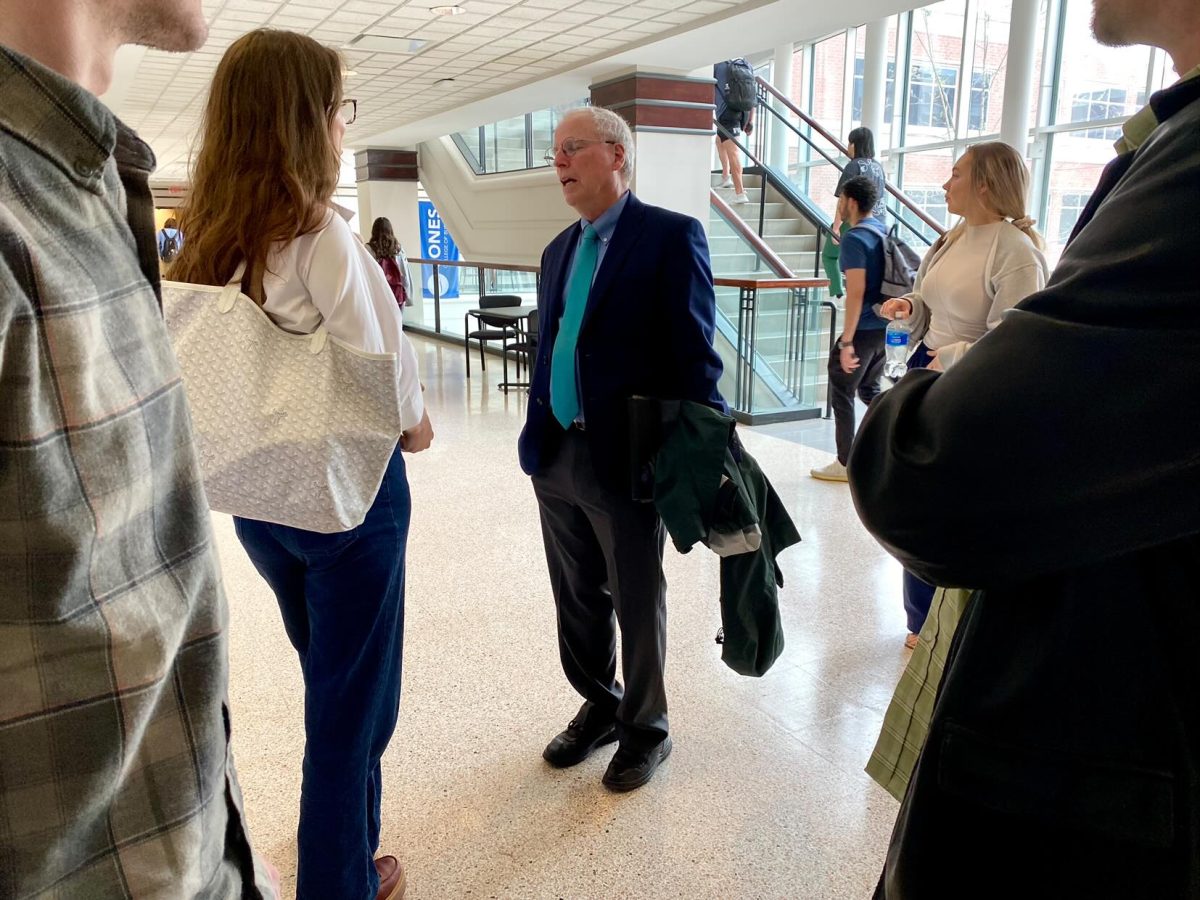By E.R. West, Erin Barnes, Emily Austin and Quint Qualls
Sidelines Staff
Even though MTSU managed to improve its retention and graduation benchmarks for receiving more funding, the university will only receive a third of the projected new dollars.
According to the Tennessee Higher Education Commission’s recommendation, MTSU should have received $4.2 million in funding. However, due to the shortage in funding, the school will only gain $1.25 million.
When revenues sink “[the formula] is not sustainable,” said John Morgan, Chancellor of the Board of Regents.
Tennessee did not make the dollars in sales tax revenue that it was projected to this fiscal year, and Gov. Bill Haslam did not allot as much of the state budget for higher education. Instead, he rolled out a new free community college plan called Tennessee Promise, which will complement his Drive to 55 initiative and reconfigure how future freshman students will receive their Hope Lottery Scholarships in 2015.
“The primary purpose is student success,” Morgan said.
Currently about 37 percent of the adult population in Tennessee has post-secondary credentials, Morgan said. He agrees that Haslam is moving higher education in the right direction with his desire to raise the percentage of adults with post-secondary credentials to 55 percent or higher by 2025.
“The governor originally had the [additional funding] in his proposed budget,” said John Cothern, university senior vice president. “But when revenue results weren’t as good as they thought they were going to be, he took all that new money out of appropriations bill.”
However, Tennessee is going to face obstacles in funding its higher education system. As Morgan explained, Tennessee’s funding is no longer based on enrollment. Instead, it is based on the college meeting benchmarks. Funding is also based on an outcomes formula.
“[The outcomes-based formula] won’t work very well if the zero-sum game becomes the pattern, because then one school’s success comes at the expense of another school,” Morgan said.
His best example was Southwest Tennessee Community College in Memphis. Because of performance declines attributed to significant enrollment declines, SWTCC should have only lost $296,700 in funding. Instead, they will lose $1.2 million, according to the THEC recommendation.
Southwest Tennessee Community College is not alone in funding it expected to see but won’t. It was recommended that Memphis receive $2.8 million in new dollars but now will only get $343,500. The University of Tennessee-Knoxville expected to receive $6.3 million and will now only receive $3.7 million. Tennessee State University also took a hit, dropping from $1.1 million to $741,400.
Including all of the universities, the THEC recommended $29 million new dollars in higher education.
Will less money affect tuition or cuts?
Because the TBR will not meet until June 20, the university will not know how much tuition will go up, nor do they know official enrollment numbers for the fall.
Tuition has increased about 50 percent since 2007. Increases have been anywhere between four to 10 percent each year. However, if tuition were to go up another six to eight percent, some students wonder how they would pay for school or if they would return.
“I would still be able to come back to school,” said Laura Cantrell, junior basic and applied science major. “However, it would be a struggle. I also have two younger brothers that still need to go through college, and this would really be a strain on my family if we all had to pay more.”
Cantrell pays for part of her tuition with the lottery scholarship, and she has also had a fund saved up for her since she was younger. However, junior business student Corey Franklin attends the university using his Pell grants and student loans.
“I believe the rise in the cost of college tuition will discourage plenty of high schoolers from pursuing higher education degrees,” Franklin said. “If I am forced to pull out another student loan and still work my way through college, I probably won’t come back here.”
For Franklin not to attend, he would have to pay another $700 to $1,000.
State officials say the tuition increase isn’t out of the norm.
“Every year tuition increases,” said Laura Herzog, deputy director of communications in Gov. Haslam’s office. “What we are seeing happen this past year and next year is normal and average for tuition. We understand that tuition increases is happening every single year.”
As for how it correlates with cuts at the university, Cothern is not sure at this stage in the year.
“Cuts, that’s [something] we won’t get into,” Cothern said. “Right now we don’t for any departments to lose money, but that could change based upon what the board does at its June meeting and what enrollment does.”
On July 1, the university has to submit a fiscal budget to the board, which will mirror the final budget for the year, is and dependent upon new fees and actual appropriations, enrollment and any changes that need to be made. The university will submit a revised budget in October for approval.
Regardless, the university is choosing to look on the bright side, even though tuition will increase and revenue will be down.
“This year, two Tennessee Board of Regents universities are gaining money on the adjustment,” Cothern said. “Other institutions are losing money based upon the adjustments and MTSU is one of the two Tennessee Board of Regents institutions that’s gaining money.”
Cothren sees the formula for higher education as sustainable, but it’s uncertain in the years when state revenue is down.
“That’s why we did not get new money,” Cothern said. “If you don’t get new money, and you have fixed costs and other required costs you have to increase like us opening the new science building, you have to adjust your budget and allocate internally. You learn how to live with less and be more economical.”
How does the outcomes-based formula work?
For many years funding for higher education in Tennessee was distributed based on enrollment of an institution. In an effort to increase graduation, the state legislature adopted the Complete College Tennessee Act (CCTA) of 2010. This initiative created a funding formula for institutions which meet certain state goals for higher education.
The main focus now is an institution’s efficiency in and the production of degrees instead of enrollment. More important now is an institution’s graduation and job placement rates, student satisfaction levels plus other variables. If an institution achieves goals or surpasses others, that school is supposed to earn more state funding for their outstanding performance.
Schools of higher learning are measured based on student progress, degrees granted, efficiency and other factors. In each institution’s formula, these metrics now play a larger role in future funding.
So instead of including student enrollment data, two sets of outcomes are identified (for four-year universities and two-year community colleges) that seem to best reflect the purpose of the institution.
Will Tennessee Promise have any effect on four-year university funding?
Tennessee Promise is the governor’s new plan to allow community college to be free. According to the governor’s press staff, he does not foresee allowing free community college tuition to negatively affect four-year institutions.
“The governor is grateful for the General Assembly’s overwhelming support of the Tennessee Promise,” Herzog said. “This makes a clear statement to Tennessee families that education beyond high school is a priority in our state. It is a bold promise that will make college a reality for more high school graduates. It speaks volumes to current and prospective employers, and it will make a difference for generations of Tennesseans.”
According to the governor’s office, the money used to fund Tennessee Promise is separate from the money placed into the funding formula. Two-year and four-year schools are funded based on outcomes, and Tennessee Promise will not change that model.
If the four-year institutions continue to graduate students at higher rates than two-year institutions, as they do now, they should see that affect their funding.
Moreover, Tennessee Promise was never designed with intention of taking the role of a four-year university, such as MTSU, nor hindering its progress. Instead, it is supposed to help the demographic of students who not go on to pursue anything other than a high school education.
“We do not think the Tennessee Promise will have a negative impact on enrollment at four-year institutions, as we are trying to bring more students into the fold—not redirect students who are already choosing four-year institutions,” the governor’s office said. “In fact, enrollment at our four-years might increase as Tennessee Promise students transfer from two-year to four-year institutions upon earning an associates degree.”
As for the Hope Lottery Scholarship, students will see more on the back end of their scholarship rather than in the beginning. This is to encourage students to finish their degrees. Students will still receive all $16,000, but it won’t be $4,000 each year.
Instead, beginning in Fall 2015, freshman and sophomores at four-year state universities will receive $3,500 per year, a reduction of $500 from what current students receive. Juniors and seniors will receive $4,500 per year.
“When we cash flowed, it wouldn’t cash-flow with $4,000 each year, and it was a negative. The average student will get $16,000 over a four year,” the governor’s office said. “This will incentivize completion and will complement the funding based formula based on tuition.”
Elisabeth Kennedy and Darrell Martin contributed to the report.
To contact the news editor, email news@mtsusidelines.com. Like us on Facebook and follow us on Twitter and Instagram @news_sidelines and @mtsusidelines.








